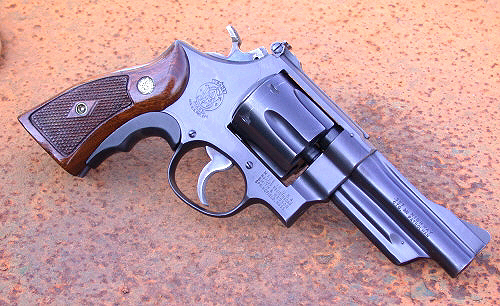
Can Less be More?
A Look at .357 Mid-range Magnums
With the number of people lawfully carrying concealed handguns growing nationwide, it appears that a good number opt for the compact 357 Magnum revolver as their personal carry weapon instead of automatics chambered in 9mm, .357 SIG, .40 S&W and so forth. Many folks simply prefer the revolver.
Initially, most are probably happy with their decision…until they get to the range!
After the initial first full-power shot, many think "God Almighty! Did it explode?" and gone is the rationale of the "inherently reliable revolver" or compactness combined with a relatively potent round being a good thing.
Let's take a closer look at some mid-power loads offered in the .357 Magnum, see what they offer and what they do not, and understand why they came to exist. Let's take a look at what they are actually meant to do.

The first .357 Magnum revolvers were from S&W. The "357 Magnum" N-frame became the Model 27, a "Cadillac" of the company's line. Later, plainer versions of the revolver were made for law enforcement or citizens wanting the power of the magnum round but in a less costly handgun. Shown is an old Model 28 "Highway Patrolman". These served the Texas Department of Public Safety and others well for decades. Like the Model 27, the Model 28 is built on the S&W large & heavy N-frame. Back in the 1930's, some of the old literature actually says that gloves are necessary to protect from the heavy recoil! Full-power loads from the N-frames, particularly in years past, were noticeable but not unmanageable. In today's super compact and lightweight revolvers, those same loads might seem like holding an exploding hand grenade with regard to felt recoil.
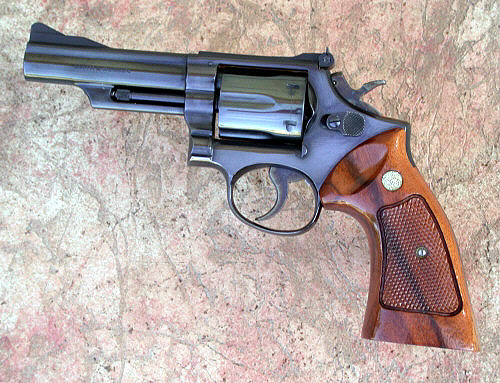
Fast-forward a couple of decades and we find the .357 Magnum being chambered in the medium-size S&W K-frame such as this Model 19 Combat Magnum. Recoil goes up as the weight and size of the revolver goes down, but the gun was much easier to carry and became immensely popular among lawmen of the era. These revolvers are still very popular with shooters today. Before long, the Model 19 was offered in the common 2 1/2" bbl for concealed carry by detectives and others wanting a more compact magnum revolver.
Much more recently, S&W has come to offer revolvers chambered for this magnum cartridge in their small J-frame revolvers. Once the province of the .32, .38 S&W and others, and the .38 Special, the J-frame in .357 Magnum has become a most popular choice among serious concealed carry revolver toters. Improvement in metallurgy and alloy combinations have allowed the gun to be made in relatively heavy for size steel guns as well as very, very light ones.
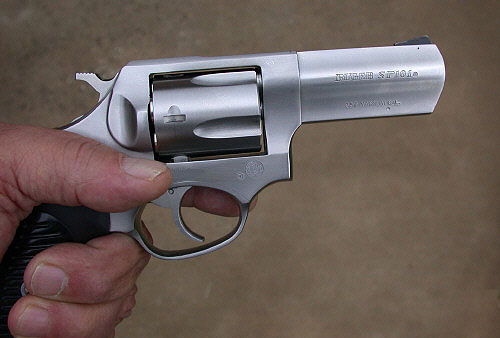
Ruger (and others) also began offering compact .357 Magnum revolvers. Shown is Ruger's 3 1/16" bbl SP101 stainless steel revolver. This compact but relatively heavy revolver is also offered in a 2 1/4" bbl. For a small belt gun, the use of a good belt and holster negate its weight "disadvantage" to me and I appreciate its recoil dampening when shooting the little thing.
There was only one thing wrong with the small three-fifty-sevens: the ammo. One could either shoot the full-power magnums suffering the consequences of stout recoil, extreme muzzle blast and flash, or go to the .38 Special, usually in +P form. This seems particularly true with the really lightweight magnum revolvers.
Finally, the ammunition makers came to the rescue. They began offering ammunition specifically intended for the compact guns.
But, there is only one problem…
None of these are full-power loads so these magnum rounds are "magnums" in name only.
But, is that necessarily bad? Let's take a close look at this aspect of defensive .357 Magnum ammunition. Will it do the job? What does it offer and what does it take off the table for the defensive shooter?
Thirty years ago the clarion call was for ammunition that actually expanded. The "adequate penetration" concern was mentioned now and again, but my recollection was not so often as today. Foot-pounds of kinetic energy was almost always discussed while today it is considered moot by many of the serious researchers and a round's KE is discussed less frequently…if at all.
The gun scribes usually touted King of the Hill in 357 as any maker's "125-grain jacketed hollow point". Usually the Remington 125-gr. SJHP or Federal's 125-gr. JHP was recommended as potent medicine for bad guys. Incidents I'm personally aware of as well as others I've only read about indicated that this full-power load usually had what it took to deck a felonious opponent.
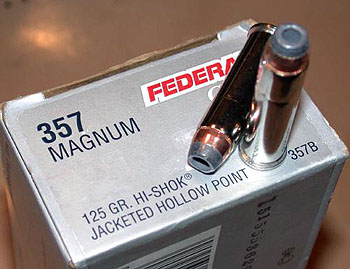
This full-power load requires at least a 4" to 6" barrel for best results. It was considered a top choice in 357 revolvers. Though it did not have flash retardant powder and used a conventional JHP, it has been described as a "manstopper" by more than a few scribes. If this is true, it comes at the cost of bright flash and sharp recoil.
At that time, these loads were normally rated at about 1450 ft/sec. When shooting an N-frame, you knew that you'd fired a gun, but I never found full-power 357 loads punishing at all in the large frame magnum. In the medium K-frame, recoil was still manageable but sharper. The L-frame 357's I've shot feel about like the N-frames to me…but felt recoil is subjective.
Put any of these full-power loads in a J-frame S&W, small-frame Taurus, or Ruger SP101 and most of will agree that felt recoil is more substantial than in the larger frame revolvers. This is hardly surprising but should a fellow suffer the harder-kicking rounds and slower recovery times or go all the way "down" to the hotter loads in 38 Special?
Currently, Remington, Corbon and Speer offer newer technology bullets loaded to lower velocities than the true magnums. I've seen some refer to it as "357 Minimum" but think a better term might be "357 Medium". To counter these loads' lower velocities, the bullets are engineered for optimum performance at these speeds.
In decades past, ammo makers used the same traditional JHP bullets in both their .38 Special and .357 Magnum loads. That usually meant that if a bullet expanded and held together in the 357 version, it would probably offer marginal expansion at 38 velocities. Likewise, a bullet that expanded rapidly in .38 Special might very well offer very little bullet integrity at higher magnum speeds.
While Corbon uses not only different DPX bullet designs in their 38 and 357 loads, the bullet weights differ as well. The 38 weighs in at 110-grains while the 357 DPX weighs 15 grains more. Remington's 125-gr. Golden Saber bullet appears to be used in both the 357 and its parent cartridge. Ditto Speer's excellent 135-gr. Gold Dot.
The difference is that the bullet's operating envelope has been tailored for maximum performance at lower than throttle-to-the-firewall velocities. They work at both mid-range magnum speeds as well as those for the .38 Special. These newer bullet designs usually penetrate deeper than older conventional JHP's in the same weight.
Expanding bullets have an operating velocity envelope; below it expansion doesn't occur but get too much above it and expansion characteristics can be quite different than expected. The homogeneous copper alloy DPX bullet is tough to get to fragment and a higher impact velocity usually means more penetration. The same thing is true of the Gold Dot. Its jacket is chemically bonded to the lead core and separation is very rare with this round. I have seen expanded bullets cranked up in handloads that resulted in the bullet nearly turning inside out, but the jacket remained with the core and their was very little weight loss. The Golden Saber's harder gilding metal jacket can separate from the lead core, but I've seen this more with expansion testing in water than on animals I've shot with the Golden Saber in various calibers. It has happened but in the few cases I've seen it, the jacket was within a couple of inches of the expanded lead bullet. I don't consider it a major issue though I'll concede that others definitely do.
In my opinion, the mid-power magnums serve a useful purpose in the small revolvers. For those limited to the use of one-hand or who are very sensitive to recoil, they might very well be a good choice in larger guns as well. For the shooter concerned with split times using full-power loads, these might be just the cat's meow. They are going to be loud inside a structure but so is any handgun cartridge. To my subjective ear, the mid-power magnums are similar to 9mm's on the range and definitely not so loud as the full-power magnums.
The three mid-power loads mentioned all use flash-retardant powders, something that is considered de rigor for modern defense loads and they use excellent bullets. Powders are optimized for substantial velocity in shorter barrels. Bullets are designed to penetrate at least 12" of 10% ballistic gelatin when firing from the compact revolvers. In the past a man wanting maximum performance from the 357 usually went with the longest barrel compatible to his needs. Today, some express concerns over using Speer's 135-gr. 38 +P and 357 in other than shorter barrels! (This is something I intend to look into further.)
The ammunition manufacturers have done yeoman's service with the R&D performed to come up with the mid-range magnum.
But are they "as good" as the full-power .357 Magnum? Are they as "powerful"?
Well, I have generally found them to be plenty accurate, sometimes surprisingly so. I have not yet found these to be shallow penetrators. I have found them to expand reliably in "soft targets" and considerably easier to shoot in the small 357 revolver. To me, all of these things are "good". Penetration is deep enough that most defense-oriented shooters would find it acceptable.
But, I do not believe that they are as "powerful" as the full-velocity .357's.
For example, from a 3 1/16" Ruger SP101, Remington's 125-gr. Golden Saber averages 1189 ft/sec while Corbon's 125-gr. DPX gets 1176 ft/sec. The full-power Winchester 145-gr. Silvertip averaged 1207 ft/sec but with 20-gr. more bullet weight (albeit an "old technology" slug). The velocities of these three are in the same ballistic ballpark, but to me "felt recoil" was significantly greater with the Silvertip. When I used a timer to measure split times (time between shots), I was as much as a half-second slower with the full-power STHP than either of the other two. This means little if hunting critters but could mean lots if facing multiple attackers or even a single determined one in a fight. The full-power Remington 125-gr. SJHP usually touted at 1450 ft/sec averaged 1293 ft/sec from the SP101, but to me its recoil is very sharp. Federal 125-gr. JHP got an average velocity of 1301 ft/sec and the trade off for it was sharp felt recoil as with the Remington and Winchester loads.
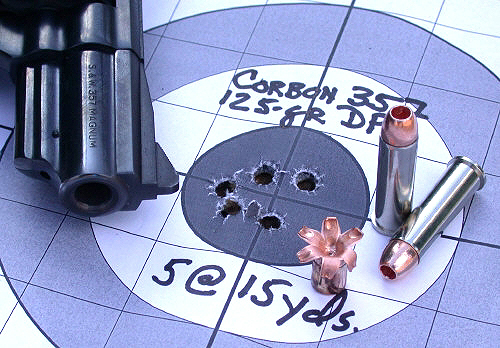
Shown is a 15-yard group from an S&W 2 1/2" Model 19. It was fired with Corbon's 125-gr. 357 DPX load and is certainly plenty accurate for most purposes. Likewise, I have found the Remington Golden Saber and Speer Gold Dot capable of tight groups as well.
The mid-power loads offer very good expansion that seems reliable. They offer penetration in line with the much touted FBI ballistic protocols and dependable accuracy in my experience.
Speaking only for myself, I believe that the mid-power magnums are the rounds of choice in the small or light 357 revolver.
Technology and hard work from the ammo designers has provided us with some loads that perform as close to perfect as anything in this power range. They have tried to give us maximum performance for considerably less recoil, but there's only so much that can be done. Newton's laws of physics are still valid and for more powerful loads, there is a price to be paid: recoil. Part of this is also due to the heavier powder charges required for these. This adds to felt recoil as well but is seldom mentioned.
The mid-power loads offer adequate penetration and expansion for self-protection in my view. It is unlikely that they offer as large a temporary cavity as full-load magnums but many researchers consider this a non-issue, a non-contributor to "stopping power." For me, the jury is still out on that one but I do believe that it contributes something. I just don't know how much and neither does anyone else from what I can find.
I believe that the mid-range magnums serve a very useful role. At the same time I do not believe that they are as potent as full-power loads like Winchester's 145-gr. STHP, but in my mind there is something more to a "good defense load" than just power. I am sure those most have read the advice to "Choose the most powerful caliber that you can handle." This is not bad information and many can handle the .357 Magnum…in the larger revolvers, but may not handle it so well in the little ones. Some say that this doesn't really matter at "self-defense ranges", the assumption being that we're speaking of distances of but a few feet or even arm's length. True enough I guess if the first shot does the trick and there is but one assailant, but maybe not if facing a dude on PCP or a couple of armed hyped-up freaks assaulting you. I believe this to be even more possible if we're being forced to fire with but one hand.
Mid-power 357 loads may offer less power than full-throttle loads but more "shootability" for many shooters while still delivering respectable incapacitation capability. Less recoil might translate into more accuracy and I still believe that placement is power. With the first round from the small revolver, be it a hard-kicking full-power 357 or less-recoiling mid-range magnum, the shooter may very well "stop" his target but he gains little if a second aggressor receives a less accurate hit requiring longer to deliver.
Though not as important as surviving a deadly encounter, there is another reason that I like the mid-power magnums from any of the three companies previously mentioned. They're not as hard on the guns as are the full-charge loads. The K-frame S&W Model 19 is a most favored revolver amongst many wheelgun fanciers, but new replacement barrels from the company are no longer available. Though I find them easy enough to use with full-power loads, I find myself shooting them with reduced power handloads or the mid-range factory loads if other than range work or hunting is the goal. Admittedly, it is not likely that a fellow will damage his K-frame with full-power 357's. I've only seen a couple of cracked forcing cones in heavily-shot K-frame 357's in three decades, but wouldn't it be the pits if it happened to your gun?
In the larger L and N-frames, cracked forcing cones are not an issue with any sane loads. The same is holding true for Ruger's line of GP revolvers. In my opinion, full-power loads can be nicely handled in these guns and I will not argue one wit with folks opting to use them for defense. At the same time, I'll wager that they can do quicker accurate shooting with the mid-power loads in these heavy steel revolvers.
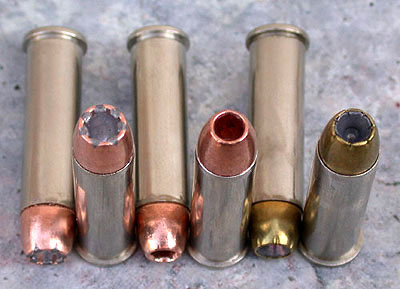
Here are three of the contenders for 357 mid-power carry loads. Left to right: Speer 135-gr. Gold Dot "Short Barrel", Corbon 125-gr. DPX, and Remington 125-gr. Golden Saber.
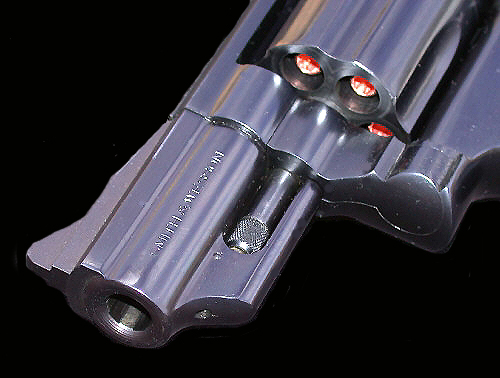
In the short-barreled 357, the mid-power load offers very good bullet performance and controllability. While these loads may not be the most "powerful" for caliber, their performance is optimized by design for use in these guns.
If a person is determined that the best 357 snub load for them remains a full-power one, I'll not argue too loudly. The choice of "best" self-protection ammunition will always remain that of the individual, at least to me. I have found that while I do appreciate all the power that can be had in this round, my performance against the clock is better with the mid-power loads.
With the smaller 357 revolvers I find that for me, less can indeed be more in terms of overall performance.
If you carry a smaller .357 Magnum revolver for self-protection, the mid-range loads might very well be worth a look.
Best.